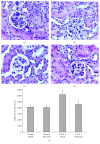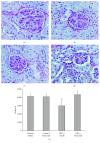Flavocoxid, a Natural Antioxidant, Protects Mouse Kidney from Cadmium-Induced Toxicity
- PMID: 29849925
- PMCID: PMC5932425
- DOI: 10.1155/2018/9162946
Flavocoxid, a Natural Antioxidant, Protects Mouse Kidney from Cadmium-Induced Toxicity
Abstract
Background: Cadmium (Cd), a diffused environmental pollutant, has adverse effects on urinary apparatus. The role of flavocoxid, a natural flavonoid with antioxidant activity, on the morphological and biochemical changes induced in vivo by Cd in mice kidney was evaluated.
Methods: C57 BL/6J mice received 0.9% NaCl alone, flavocoxid (20 mg/kg/day i.p.) alone, Cd chloride (CdCl2) (2 mg/kg/day i.p.) alone, or CdCl2 plus flavocoxid (2 mg/kg/day i.p. plus 20 mg/kg/day i.p.) for 14 days. The kidneys were processed for biochemical, structural, ultrastructural, and morphometric evaluation.
Results: Cd treatment alone significantly increased urea nitrogen and creatinine, iNOS, MMP-9, and pERK 1/2 expression and protein carbonyl; reduced GSH, GR, and GPx; and induced structural and ultrastructural changes in the glomeruli and in the tubular epithelium. After 14 days of treatment, flavocoxid administration reduced urea nitrogen and creatinine, iNOS, MMP-9, and pERK 1/2 expression and protein carbonyl; increased GSH, GR, and GPx; and showed an evident preservation of the glomerular and tubular structure and ultrastructure.
Conclusions: A protective role of flavocoxid against Cd-induced oxidative damages in mouse kidney was demonstrated for the first time. Flavocoxid may have a promising antioxidant role against environmental Cd harmful effects on glomerular and tubular lesions.
Figures







References
MeSH terms
Substances
LinkOut - more resources
Full Text Sources
Other Literature Sources
Medical
Miscellaneous

